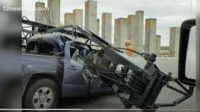Clues to Causes of Fatal Florida Tower Crane Accident Point to Platform Cable

Work platform on red climbing unit, tilted and supported by a single cable near the center of the photograph, is likely to be a key focus in the Fort Lauderdale project accident fatality probe.
Photo: Fort Lauderdale Fire Rescue
Clues about what may have happened at a fatal Florida tower crane accident in April suggest that a cable supporting the climbing unit work platform failed, detached or was cut.
A post-accident photo of the climbing unit and a video description by the rigging crew boss both point to the role of the platform cable, suggests William Neeley, who trains crane operators for Crane Tech LLC, a national crane services company based in Tampa, Fla.
A police report obtained by ENR stating that one work platform cable was "loose and frayed" while another was still intact and attached may add to investigators' interest in the cable.
The mishap sent a heavy tower crane mast section on the platform, being prepared for insertion during a climbing operation, crashing to a bridge roadway adjacent to the apartment tower in Fort Lauderdale, Fla. As the mast section toppled from the platform, a rigger, 27-year-old Jorge De La Torre, fell about 300 ft to his death.
The mast section crushed a hatchback passing on the road below, although its driver escaped comparatively unharmed. Other cars also were hit by debris and one person received a head laceration.
In the days following the accident, Neeley suspected the climbing unit work platform was involved after seeing a photograph posted online by Fort Lauderdale Fire Rescue that was used in news reports.
To comply with Florida state public records law, Fort Lauderdale police released on July 18 multiple videos of the mast section crashing down on cars as well as body camera recordings from local officers who rushed to the jobsite and interviewed crew members.
The video shows the upper portions of the building, the blue tower crane mast, the red climbing unit and the work platform that hinges out from it. The platform's outer edge should be tied to the climbing unit by cables at the edge corners, but in this case that outer edge seemed to be tied to the climbing unit only from a single cable.
Whether the platform's tilt and the apparently missing support cable were the triggering causes or part of a chain of events, and whether the cable had been inadvertently cut, failed or pulled from an anchorage, can't be known yet, Neeley said.
One worker, who identified himself as Francisco Manuel Tobias and said he was the crew boss for Phoenix Rigging & Erecting, twice responded to police who were collecting names and contact information, offering vivid descriptions to officers.
After learning of Tobias' video description, Neeley said it squares with his theory made in April.

Francisco Manuel Tobias, left, describing to a police officer what he believe happened on April 4.
Image: courtesy of the Fort Lauderdale Police
“We were just fixing something ... and the crew was just going to take a jump over to the other side," Tobias told one officer, apparently meaning that the mast section would be inserted.
Then, "we just heard a loud noise, and the tower just fell,” he added, apparently referring to the crane's mast section. The crane mast, attached at intervals to the building frame, was never in danger of collapsing.
Tobias indicated the tower or tower section “was just standing there,” on the platform and “It was just waiting there, and I’m guessing this snapped," he said, grabbing a cable at the back of the tool shed truck. The crew boss said he was tied off and able to hold on, saving himself.
A police report also suggests that the work platform cable may be part of the failure sequence. Officer Jaclyn Smith, who entered the building shortly after the accident, observed that one climbing unit work platform cable was in place while another was "loose and frayed" and unattached. She also observed that "loose wires were attached" to the end of the climbing unit work platform where the loose and frayed cable had apparently failed or detached.
Federal safety officials are still investigating the accident.
The police report also contains details that may partially explain why the crew was deeply shocked: the force of the 30-plus-story fall that killed De La Torre inflicted severe injuries and his remains were still at the jobsite 30 or 40 steps from the toolshed. It's likely the crew members had seen the injuries.
A Gofundme page has been set up by De La Torre's family, which includes two children.
 A Gofundme page was set up for rigger Jorge De La Torre, who was the father of two and died in the accident.
A Gofundme page was set up for rigger Jorge De La Torre, who was the father of two and died in the accident.
What happens next from a legal perspective will probably involve the separate companies often involved when a tower crane is used on a project: the crane operator's employer, the crane or climbing unit owner and the rigging contractor.
But, says Neeley, the task of assigning legal responsibility "gets real sketchy because in the tower crane world, the operator sitting above is not in charge of" or under the control of the rigging crew.




